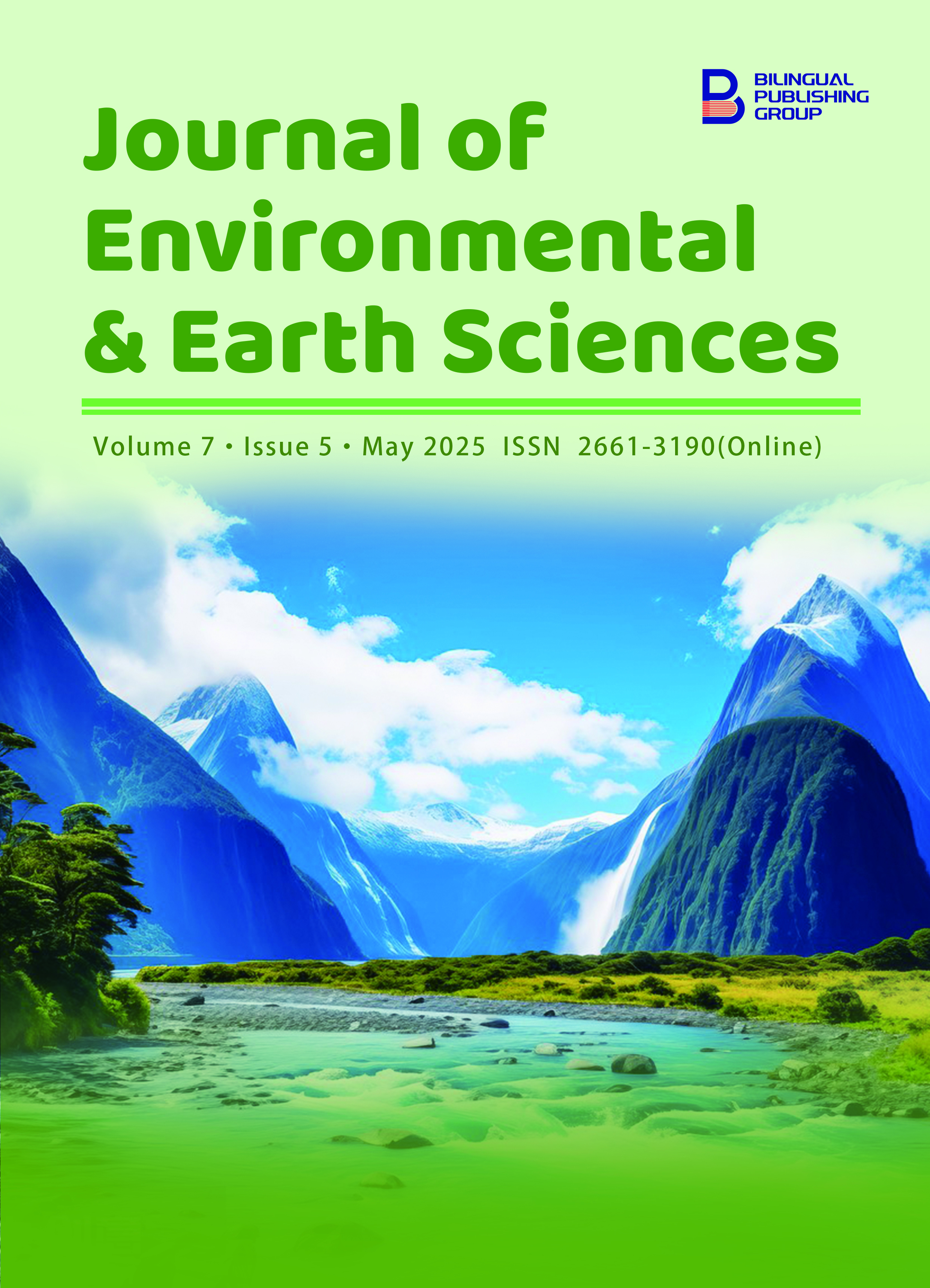
Volcanic Geomorphology and Morphometry Classification of Cinder Cone in Harrat Lunayyir Saudi Arabia by Using GIS and Remote Sensing
DOI:
https://doi.org/10.30564/jees.v7i5.8859Abstract
Harrat Lunayyir, a volcanic field in western Saudi Arabia, exhibits diverse geomorphological and topographical features shaped by volcanic, tectonic, and climatic processes. This study integrates field observations, remote sensing, and GIS analysis to investigate the spatial distribution and relationships between volcanic landforms, lava flows, and topographical variation result obtained is a morphological classification of the cinder cones of Harrat Lunayyir, which can be sub-divided into four types: tephra rings, horseshoe-shaped volcanoes, multiple volcanoes and volcanoes without craters.All of these are monogenetic volcanoes, unlike central volcanoes (stratovolcanoes) which live for tens or hundreds of thousands of years and erupt numerous times. In Harrat Lunayyir, there is a clear dominance of arched horseshoe-shaped volcanoes (58) over ring-shaped cinder cones (10), A1_symmetric cones (circular, uniform cinder cones with a single crater) (32), A2_asymmetric cones (elongated, irregular cones and may feature one or more craters) (8), volcanoes without craters (55) and multiple volcanoes (20). The classification presented in this paper makes it possible to include all morphological types of volcanoes found in the region. This fact also renders the present classification a useful tool to apply in other, both insular and continental volcanic areas to eventually analyze and systematize the study of eruptive edifices with similar traits. Hence, this research will explore the standard physical volcanology literature so as to follow accepted definitions.
Keywords:
GIS; Morphology; DEM; Topography; Lithology; Cinder ConesReferences
[1] Al-Amri, A., Fnais, M., Abdel-Rahman, M., et al., 2012. Geochronological dating and stratigraphic sequences of Harrat Lunayyir, NW Saudi Arabia. International Journal of Physical Sciences. 7, 2791–2805. DOI: https://doi.org/10.5897/IJPS12.178
[2] Al-Zahrani, N., Baron, D., Sabourin, A., 2013. Ste20-like kinase SLK, at the crossroads: a matter of life and death. Cell Adhesion & Migration. 7(1), 1–10. DOI: https://doi.org/10.4161/cam.22495
[3] Kervyn, M., Ernst, G., Goossens, R., et al., 2008. Mapping volcano topography with remote sensing: ASTER vs. SRTM. International Journal of Remote Sensing. 29(22), 6515–6538. DOI: https://doi.org/10.1080/01431160802167949
[4] Criado, A., 1984. Lattice dynamics and thermal crystallographic parameters in phenothiazine. Acta Crystallographica Section A: Foundations and Advances. 40(6), 696–701. DOI: https://doi.org/10.1107/S0108767384001422
[5] Omar, G., Steckler, M., 1995. Fission track evidence on the initial rifting of the Red Sea: Two pulses, no propagation. Science. 270(5240), 1341–1344. DOI: https://doi.org/10.1126/science.270.5240.134
[6] Dehn, J., 2002. Thermal precursors in satellite images of the 1999 eruption of Shishaldin Volcano. Springer natuew link. 64, 525–534.
[7] Corazzato, C., Tibaldi, A., 2006. Fracture control on type, morphology and distribution of parasitic volcanic cones: an example from Mt. Etna Italy. Journal of Volcanology and Geothermal Research. 158, 177–194. DOI: https://doi.org/10.1016/j.jvolgeores.2006.04.018
[8] Thordarson, T., Self, S., 1993. The Laki (Skaftár Fires) and Grímsvötn eruptions in 1783–1785. Bulletin of Volcanology. 55, 233–263. DOI: https://doi.org/10.1007/BF00624353
[9] Wood, C.A., 1980. Morphometric evolution of cinder cones. Journal of Volcanology and Geothermal Research. 7(3–4), 387–413. DOI: https://doi.org/10.1016/0377-0273(80)90040-2
[10] Bonatti, P., Colantoni, B., Della, V., et al., 1984. Geology of the Red Sea transitional zone (22°N – 25°N). Oceanologica Acta. 7(4), 385–398.
[11] Baer, G., Hamiel, Y., 2010. Form and growth of an embryonic continental rift: InSAR observations and modelling of the 2009 western Arabia rifting episode. Geophysical Journal International. 182, 155–167. DOI: https://doi.org/10.1111/j.1365-246X.2010.04627.x
[12] Stern, R., Johnson, P., 2010. Continental lithosphere of the Arabian Plate; a geologic, petrologic, and geophysical synthesis. Earth-Science Reviews. 101, 29–67. DOI: https://doi.org/10.1016/j.earscirev.2010.01.002
[13] Manville, V., Németh, K., Kano, K., 2009. Source to sink: a review of three decades of progress in the understanding of volcaniclastic processes, deposits, and hazards. Sedimentary Geology. 220(3–4), 136–161. DOI: https://doi.org/10.1016/j.sedgeo.2009.04.022
[14] Romero, R., Carrasco, D., Araña, V., et al., 2003. A new approach to the monitoring of deformation on Lanzarote (Canary Islands): an 8-year radar perspective. Bulletin of Volcanology. 65, 1–7. DOI: https://doi.org/10.1007/s00445-002-0232-3
[15] Stoeser, D., Camp, E., 1985. Pan-African microplate accretion of the Arabian Shield. Geological Society of America Bulletin. 96(7), 817–826.
[16] Le Corvec, N., Spörli, B., Rowland, J., et al., 2013. Spatial distribution and alignments of volcanic centers: clues to the formation of monogenetic volcanic fields. Earth-Science Reviews. 124, 96–114. DOI: https://doi.org/10.1016/j.earscirev.2013.05.005
[17] Riedel, C., 2003. Controls on the growth and geometry of pyroclastic constructs. Journal of Volcanology and Geothermal Research. 127(1–2), 121–152. DOI: https://doi.org/10.1016/S0377-0273(03)00196-3
[18] Porter, C., 1972. Distribution, Morphology, and Size Frequency of Cinder Cones on Mauna Kea Volcano, Hawaii. Geological Society of America Bulletin. 83, 3607–3612.
[19] Doniz Paez, F.J., 2004. Caracterización geomorfológica del volcanismo basáltico monogénico de la isla de Tenerife [Doctoral dissertation]. Universidad de La Laguna: La Laguna, Spain.
[20] Thouret, J.-C., 1999. Volcanic geomorphology—an overview. Earth Science Reviews. 47, 95–131. DOI: https://doi.org/10.1016/S0012-8252(99)00014-8
Downloads
How to Cite
Issue
Article Type
License
Copyright © 2025 Azizah Aziz al Shehri

This is an open access article under the Creative Commons Attribution-NonCommercial 4.0 International (CC BY-NC 4.0) License.







 Azizah Aziz al Shehri
Azizah Aziz al Shehri





